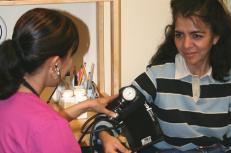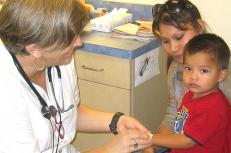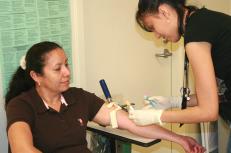Editor's Note: Austin is regularly listed as one of the best places to live in the country. Yet according to the Travis County Suicide Data Project, Travis County had the highest suicide rate of any major Texas county from 2000-2005. In 2005, suicide cost Travis County $700 million.
Suicide rates are indeed an indicator of a region’s emotional health, and ours point to the fact that more of us here in Austin are living with mental health issues and chronic stress than our happy-go-lucky, Keep Austin Weird vibe would imply.
While genetic background and family upbringing play a part in an individual’s mental health, stress is one of the most common causes and indicators of deeper mental health problems. Stress is particularly pronounced in the Latino community, especially among recent immigrants, for whom cultural and economic factors add additional stressors and barriers to care.
In this article, Behavioral Health Specialist Orlando De Leon, LCSW, discusses how El Buen Samaritano Episcopal Mission is applying an integrated health model to help its clients resolve stress, find balance and live healthy lives.
Stress affects everyone and every part of our lives. When we have problems weighing on our minds or when we feel anxious, there is often a physical reaction as well as an emotional one. If we do not have a variety of coping skills, stress can dominate our lives and directly harm our health.
In my 20 years in the field of social services, I have found that we don’t have to be suicidal or clinically depressed for stress to affect our health. Stress is often a hidden disease: we rarely address it directly as the root cause of a physical ailment, and we often try to just deal with it on our own or ignore it and only treat the physical ailment. It can be compared to high blood pressure—often, the symptoms remain hidden from the patient until he or she can no longer cope. The signs can be clear, but professional assessment is needed to determine how it impacts the person and his or her family.
There are many barriers to helping individuals identify and resolve stress before it consumes them. Recently, I began working with a gentleman who spent more than one month struggling to survive amidst significant stress. 
As the stress mounted, he was on the verge of creating additional trauma for himself, his family and people around him. It was only after a complete physical collapse that he found the support he needed at El Buen Samaritano. Read his story.
Did you know? There’s a gap in access to behavioral health services in Travis County. Behavioral-health-related ER cases increased 84 percent between 2006 and 2007.
In Travis County, we simply do not have enough behavioral health specialists, especially Spanish-speaking behavioral health specialists. Even for paying clients, there can be a four to six-month waiting period to see a psychotherapist or psychiatrist in Austin. The gap for Spanish-speaking mental health providers and those who will take Medicare or Medicaid is even greater.
One of the consequences of this shortage is a dramatic increase in the number of individuals presenting to emergency rooms with primary behavioral health complaints. According to the 2009 Travis County Community Impact Report, behavioral-health cases in Travis County emergency rooms increased 84 percent between 2006 and 2007.
Adding to this is the general and unfortunate stigma attached to seeking behavioral or mental health care in the Latino community. Many Latinos associate “social worker” with child protective services, and “psychologist” with mental institutions or severe mental illnesses, such as schizophrenia.
Through the support of the St. David’s Foundation, El Buen Samaritano’s Wallace Mallory Clinic works from an integrated behavioral health model that recognizes the direct links between stress, mental health and physical health. We believe that stress is a key factor in health, and that it is critical that we treat it just as we would a tumor or broken limb. We may offer medication if appropriate, but will identify behavioral and mental health opportunities to complement medical procedures.
Because at El Buen Samaritano we recognize the importance of normalizing the way patients feel and dispelling the myths about seeking mental health care, we also work to find the core causes of stress rather than giving a label or diagnosing. We choose words that do not have a history tied to them and act as a “helper” or “coach.” If we can help patients understand that mental health discussions are healthy and helpful, we can address stress before it affects physical health.
The following list describes common physical ailments that are caused or exacerbated by stress and explains how El Buen Samaritano’s integrated health care model helps patients prevent stress from dominating their lives so they can lead healthy and productive lives:
Aches and Pains
Many of us might be surprised to know that stress is the culprit for our shoulder pain or headache.
Did you know? You can reduce your random aches and pains by taking a deep breath every now and then.
We live in such a fast-paced society, where we can get so caught up in daily survival—paying bills, going to work, taking care of the kids. We don’t call it stress, or anxiety, or depression—we don’t put a label on it—because we are just trying to make it to the next paycheck or the next day. Rather than address what is causing the stress, we are more likely to treat the aches and pains caused by stress. We’ll take pain medication or medication to help us sleep or even increase alcohol use, but we will forget that those aches and pains will return when the stress returns.
At El Buen Samaritano, many of our patients are first and second-generation immigrants who face high levels of stress because they are adjusting to living in an environment that is very different from the one they are accustomed to. Often, our patients are living in multigenerational households where everyone is functioning at a very different level of assimilation or acculturation to American culture.
When we see patients with chronic aches and pains, we may also help them cope with the stressors caused by acculturation. It is important to note here the difference between acculturation and assimilation to better understand how Latinos in the United States cope with a new culture: acculturation—deemed by many as the healthier choice—is the process of acquiring a second culture, and assimilation is the process of replacing one's first culture with a second culture.
Due to the rapid growth of the Latino population in the United States and the recognition of its importance by commercial and political forces, it has been hypothesized by many—including Dr. Felipe Korzenny, founder and director of Florida State University’s Center for Hispanic Marketing Communication—that Latinos are more likely to acculturate, or become bicultural, than they are to assimilate and thus abandon their original culture. El Buen Samaritano’s integrated behavioral health services can help the individual and the entire family learn—or relearn—positive coping skills and can help us all start conversations regarding family stresses and acculturating to new lives and the expectations of a new country.
Many techniques for coping with stress are not often taught or have been forgotten in our day-to-day hectic lives. Something as enjoyable as having a conversation or taking a deep breath can significantly alleviate or prevent the symptoms of stress and lead to less reliance on medications or improved outcomes when medications or other short-term solutions are used.
Gastrointestinal & Digestion Issues
In children, one of the first ways we see stress in the body is with a stomachache. Something bad has happened, and they don’t want to go to school or want to come home because “my tummy hurts.” For us adults, the stomach has a direct connection to stress, as well.
Did you know? A casual dinner with friends or family can lower your chances of experiencing gastrointestinal and digestion problems caused by stress.
When it comes to what we eat, stress sneaks up and encourages the “easy” choice. It is much easier to go through the drive-through or grab a frozen TV dinner—cheap, high-fat, high-sugar fast food. If this becomes part of a regular diet, it affects our weight, the way we feel, our digestion and our ability to sleep, not to mention other aspects of our health, adding to the overall effects of stress on ourselves and our families. All of this may harm our quality of life and decrease our longevity.
I always encourage families at El Buen to try to eat together every night and turn off all devices at that time. It is amazing what happens. Stopping to eat and listen to family members without distractions can provide tremendous stress relief and help the body recuperate.
Panic Attacks
Panic attacks are another common manifestation of stress. A number of clients report that they have pulled over while driving and called Emergency Medical Services because their pulse was racing, their heart was pounding and they thought they were having a heart attack.
If we have ruled out a heart attack, managing stress is the primary tactic for preventing another panic attack. Patients at El Buen will see a health care provider to help identify what is causing such stress, but there is often hesitation at the beginning of our discussions—people want to know if we think they are crazy.
Once a health care provider refers the patient to me, I assess the patient’s situation and teach culturally appropriate techniques for relieving stress. Often, these techniques include encouraging the client to participate in El Buen Samaritano’s Healthy Living programs, which include exercise, yoga and nutrition classes.
High Cholesterol & Hypertension
Did you know? Stress increases the production of cholesterol in your body.
When you encounter stress, your body often goes into “fight or flight” mode. Your brain releases two hormones, adrenaline and cortisol, so that you can react quickly. Both hormones trigger the production of cholesterol. Too much cholesterol can clog the arteries and eventually lead to a heart attack or stroke. Moreover, if you face a good deal of stress without getting rid of the high levels of hormones the body produces—as with modern-day stressors that don't require an actual physical fight or escape—those hormones are gradually accumulated as fat tissue somewhere in the body.
For El Buen Samaritano’s clients who face economic pressures (another major stressor), medications that can manage high blood pressure and high cholesterol are not always an option, as some of our patients do not have the financial resources to fill a prescription—even if it is a $5 prescription. While we provide many medicines and services for free or on a sliding scale, El Buen Samaritano’s Healthy Living programs’ alternative lifestyle and stress-management solutions are often more effective in the long run.
Suicide & Depression
Often patients come in to El Buen for a wellness check, and just as they are leaving, say, “I feel so sad” or “I just don’t think I can do this anymore.” A health care provider hears that as an obvious cry for help, and is fully aware that many people lack the time and resources to know how and where to seek help.
Our health care providers are well in tune with our clients’ culture, and when they hear these key phrases, they are quick to act by connecting them to the appropriate support services immediately.
Conclusion: Stress can affect the entire Austin community
While many common physical ailments are caused or exacerbated by stress, these physical ailments can be addressed by applying tips and techniques to keep stress under control.
Seeing how the Latino population of Austin has increased from 23 to 35 percent in the last 20 years and it will continue to grow—according to the city’s demographer, Ryan Robinson—, the Austin community would benefit a great deal if lessons from the aforementioned behavioral health model were applied to improve health and wellness all throughout Austin.
When we fail to deal with stress in healthy ways, we all pay the price. Stress results not only in catastrophic health consequences, but also in societal breakdown as well. We see and hear about a suicide and a heart attack, but we do not hear or recognize the effects of stress on no-show rates at work, neighbors fighting, school truancy, strain on the ER, substance abuse, domestic violence and lack of productivity at work. Everyone in the community feels the effects, but we do not recognize them.
Stress-relieving techniques, an integrated health model and a greater number of behavioral health care providers could help everyone in Austin understand and cope with stress before it affects our physical and social health.





















